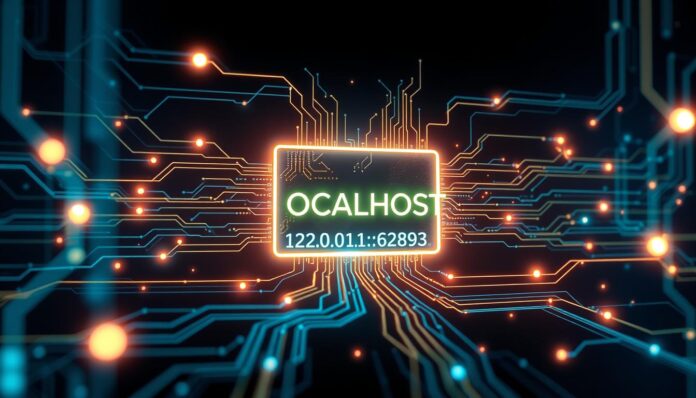Local port 127.0.0.1:62893 is key for better digital experiences. This guide explores localhost setups and the loopback address in network connections.
This is a digital illustration of a glowing, futuristic computer interface displaying the concept of “localhost,” with intricate network connections and data flow set against a dark, sleek background. The scene should capture the essence of local networking, with visual elements representing data packets and virtual pathways converging at the focal point of the local port 127.0.0.1:62893, surrounded by abstract technology motifs and glowing circuitry.
We’ll cover how to manage and fix your local network connections. You’ll learn about port 62893 and localhost security.
This guide will help you improve your network setup and gain skills to boost your local network’s potential.
Understanding Localhost and Loopback Address
Localhost is crucial in network communications. A unique IP address (127.0.0.1) refers to the local device.
This address tests network apps without using external networks. It helps developers check their work.
The loopback address lets a device talk to itself. It’s excellent for testing and fixing issues.
127.0.0.1 is used across all systems. This makes it a universal tool for developers.
Knowing about localhost helps with network apps. It makes testing more straightforward and more efficient.
Exploring the Significance of Port 62893
Port numbers are vital for network communication. Port 62893 is a standard port used by various applications.
This port supports many applications, from system diagnostics to specialized software. It allows programs to exchange data and work together smoothly.
Sometimes, multiple apps try to use the same port. This can cause conflicts that need to be fixed.
Understanding port 62893 helps with network connectivity issues. It helps fix problems and improve system performance.
Knowledge of this port aids in developing apps that use it. It also helps manage networks more effectively.
How to Access 127.0.0.1:62893
You can reach 127.0.0.1:62893 in different ways. These methods suit various skill levels and preferences.
The easiest way to access the local port is to type “127.0.0.1:62893” in your browser’s address bar.
You can set up client software to connect. This works for FTP clients or remote desktop apps.
Command line fans can use built-in networking tools. This gives more control and flexibility for local connections.
Accessing 127.0.0.1:62893 helps you understand local network links. Learning these methods will improve your tech skills.
Troubleshooting Connection Issues
Network connectivity can be tricky, especially with local connections like 127.0.0.1:62893. Let’s explore some helpful troubleshooting techniques.
First, check if port 62893 is open. Use tools like netstat or lsof in your terminal.
If the port is open, look at your firewall settings. Make sure it’s not blocking localhost or the specific port.
Sometimes, network drivers cause problems. Update your drivers and reset your network stack.
Check your system logs for network errors. This can help find hidden issues.
By following these steps, you can fix connection issues. This will ensure smooth local network connectivity.
Security Considerations for Localhost Connections
Local host connections require strong security measures. Protecting your local network is vital to prevent unauthorized access.
The localhost address, 127.0.0.1, needs special attention. Robust security measures can stop unwanted intrusions.
Update your system’s software regularly. Apply security patches and configure your firewall to limit access.
Use SSL/TLS encryption for secure network connections. This protects data sent between local apps and localhost.
Monitor network traffic to spot suspicious activities. Use tools to detect unauthorized access attempts quickly.
These steps can lower the risks of data breaches. They help maintain your local network’s integrity and reliability.
Tools for Managing Local Connections
Network pros use many tools to manage local connections. These tools help maintain and fix your local network.
Wireshark is a popular open-source network analyzer. It captures and examines network traffic to find issues.
Nmap scans your local network for open ports. It helps find potential security weak spots.
Windows Defender Firewall and Pfsense help set up firewalls. They let you create custom rules and watch network activity.
These tools help you understand your local network better. They can find and fix connection problems quickly.
Using these tools improves how you manage local connections. They also help keep your systems and data safe.

Advanced Configuration Options
Customize your network with 127.0.0.1:62893. Learn about proxy setup and local development in this guide.
Adjust settings such as IP address, port number, and network protocols to tailor your 127.0.0.1:62893 connection to your needs.
Set up a proxy server on 127.0.0.1:62893 for secure internet traffic. This enhances privacy and helps bypass content restrictions.
Create a local development environment on 127.0.0.1:62893. Test and debug apps without using a remote server.
Integrate your local setup with cloud services and version control. This streamlines your workflow and boosts productivity.
Explore these options to improve your 127.0.0.1:62893 experience. Enhance security and unlock the power of customization.
Developing Applications on 127.0.0.1:62893
Local port 127.0.0.1:62893 is great for app development. It allows developers to easily build, test, and fix apps.
This local address helps streamline debugging. Developers can spot and solve issues quickly without remote server problems.
A digital workspace features a sleek laptop displaying code on the screen, surrounded by various tech gadgets like a smartphone, tablet, and IoT device. The background includes abstract representations of network connections, with glowing nodes and lines symbolizing data flow. A cosy atmosphere with soft lighting, potted plants, and a coffee cup on the desk creates an inviting environment for localhost app development.
The local setup offers many perks. It allows fast changes and instant feedback.
Developers can test apps in a controlled setting. This boosts productivity and reduces deployment errors.
Using 127.0.0.1:62893 improves localhost app development. It helps create strong, reliable apps more efficiently.
Future Trends in Local Network Connectivity
Local network connectivity is changing fast. New tech like IPv6 will reshape how we use ports and communicate locally.
IPv6 is taking over from IPv4. It offers more space for addresses and better features.
IPv6 will make networks more efficient and secure. It can handle many more connected devices in our local areas.
New ways to manage ports are coming. These will make local networks more flexible.
These changes will keep our connections quick and reliable and adapt to users’ and apps’ needs.
FAQ
What is the purpose of the local port 127.0.0.1:62893?
The local port 127.0.0.1:62893 is used for testing on a local computer. It helps access apps running on the same machine.
What is the significance of the IP address 127.0.0.1?
127.0.0.1 is the loopback address, also known as localhost. It lets apps talk to each other on the same system.
How can I access the local port 127.0.0.1:62893?
You can use web browsers, client software, or command-line interfaces. The steps depend on the app running on the port.
What are some typical applications or services that use port 62893?
Port 62893 is often used to host local web servers, test network apps, and manage database systems.
How can I troubleshoot connection issues with 127.0.0.1:62893?
Check firewall settings and make sure the app is running. Use network tools to find port conflicts or access problems.
What security considerations should I keep in mind when using localhost connections?
Monitor network traffic and ensure proper access controls. Keep software up-to-date to reduce risks.
Avoid exposing local host connections to external networks or the internet.
What tools can I use to manage and monitor local network connections?
Use network diagnostic utilities and firewall configuration software. Port scanning apps can also help manage local connections.
How can I set up advanced configuration options for 127.0.0.1:62893?
Try customizing network settings and using proxies or tunnels. Set up local development environments for more options.
What are the benefits of developing applications on 127.0.0.1:62893?
You can test and debug locally without a remote server. It offers a self-contained development environment.
You can also customize network settings for better performance.
What future trends can we expect in local network connectivity?
We’ll see more use of IPv6, new networking protocols, and better tools for managing local networks will also be developed.
You can also read more : Elon Musk Trading App: A Comprehensive Guide to Automated Investment Platforms



